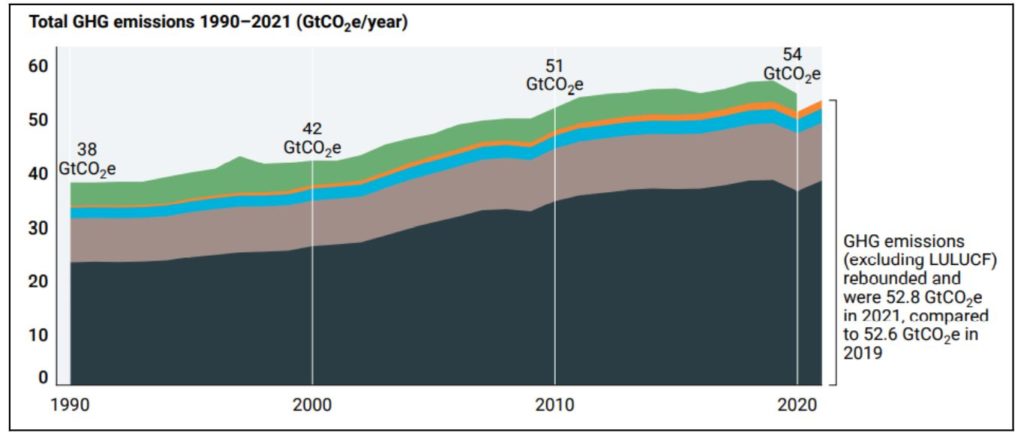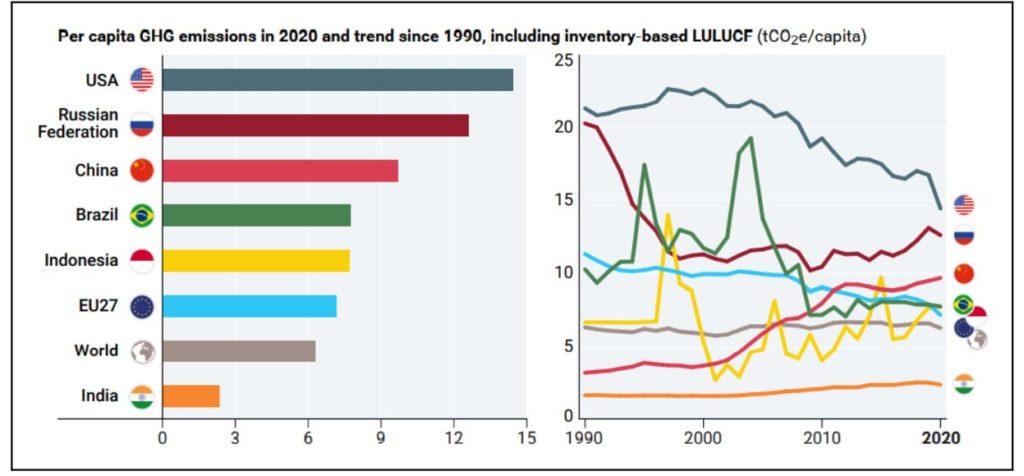UNEP’s latest report released ahead of COP27, ‘Closing Window – Climate crisis calls for rapid transformation of societies’ finds that the international community is falling far short of the Paris goals, with no credible pathway to 1.5°C in place. The latest report is a testimony to inaction on the global climate crisis.
The United Nations Environment Programme (UNEP) recently released the thirteenth edition of the annual Emissions Gap Report ahead of the 27th Conference of Parties that is taking place in Sharm el-Sheikh, Egypt. As the name suggests, the report highlights the global trends in emissions of greenhouses gases (GHGs) and provides an overview of the gap between the projected emissions by 2030 and the levels to be maintained as per the Paris Agreement in order to limit the global temperature rise to well below 2°C.
The latest report, ‘Closing Window – Climate crisis calls for rapid transformation of societies’ finds that the international community is falling far short of the Paris goals, with no credible pathway to 1.5°C in place. The latest report is a testimony to inaction on the global climate crisis. It noted that despite the decision made in COP26 in 2021 held at Glasgow, UK to strengthen Nationally Determined Contributions (NDCs) for 2030, the progress has been poor.
Global GHG emissions are reaching new record levels
According to the report, the rate of growth of global GHG emissions was slower than in previous decades. The average annual growth rate was 1.1% per year between 2010 and 2019, while it was 2.6% in the period from 2000 to 2009, thanks to the reduction in new coal capacity additions and the shift to gas and renewable energy sources instead of coal.
However, the total global GHG emissions were 54.4 gigatons CO2 equivalent (GtCO2e) between 2010 and 2019, the highest ever. The emissions are expected to remain the same as in 2019 levels or increase further in 2021. GHG Emissions excluding that from land use, land use change, and forestry (LULUCF) was 52.8 GtCO2e in 2021 as compared to 52.6 GtCO2e in 2019. In 2020, because of the pandemic, the total global GHG emissions dropped 4.7% compared to 2019. It was the largest single-year absolute drop since 1970. Nonetheless, towards the end of 2020, the CO2 emissions from fossil fuel and industry had rebounded.

G20 countries are alone responsible for 75% of the emissions globally
In 2020, seven countries (China, USA, European Union, India, Indonesia, Brazil, and Russia which are G20 members) and international transport contributed to more than 55% of the total GHG Emissions. The emissions of these 8 emitters were 32.8 GtCO2e in 2019, dropping by 3.8% to 31.5 GtCO2e in 2020. Together, G20 nations contributed to 75% of the total emissions in 2020. The emissions from China, India, Russia, Brazil, and Indonesia in 2021 were higher than in 2019, the year before the pandemic. While the emissions had increased by 5.9% in China and 6.8% in Indonesia in this period from 2019 to 2021, the emission from international transport was 15.9% lower than the pre-pandemic levels.
Though in 2020, India became the third highest emitter of GHG after China and USA, the per capita GHG emission of India was only 2.4 tCO2e, much lower than the global average of 6.3 tCO2e. The average annual per capita emission of least developed countries was 2.3 tCO2e, as per the report. On the other hand, despite a decline in the per capita emissions in the last decade, the per capita emission of the USA was 14 tCO2e and Russia’s was 13 tCO2e. Among the other top emitters, the per capita emission of China was 9.7 tCO2e while Brazil’s and Indonesia’s were 7.5 tCO2e each and European Union’s was 7.2 tCO2e.

USA and EU responsible for 42% of the cumulative emissions between 1850 to 2019
The USA contributed to 25% of the total fossil CO2 emissions from 1850 to 2019 while European Union contributed to 17%. China was responsible for 13% and Russia 7%. Only 3% was contributed by India and 1% each by Brazil and Indonesia. The least developed countries contributed to 0.5% of the total emissions during this period.
Going by the current practices, a 2.8°C hike in temperature is expected by 2100
Nationally Determined Contribution (NDC) is a climate action plan to cut emissions and adapt to climate impacts. Countries define targets, and measures to reach them, and monitor the progress toward achieving the target. In COP26, member countries adopted the Glasgow Climate Pact and revised their NDCs with strengthened targets to achieve the Paris targets. But the revised NDCs were such that they could only reduce the projected greenhouse emissions by 1% by 2030. It is roughly equivalent to 0.5 gigatonnes of CO2. In other words, these would make negligible difference to the projected emissions in the next 8 years. Also, none of the G20 members are on track to achieve the new or updated NDCs.
If the policies currently being implemented are not improved, a 2.8°C increase in temperature is anticipated in this century as against the Paris targets to limit the temperature rise to 2°C and 1.5°C. Even if all the unconditional NDCs or those NDCs for which countries do not require any financial or technical support from other countries are achieved, the temperature can still rise by 2.6°C by 2100. If the conditional NDCs are also achieved, then the temperature rise can be limited to 2.4°C. If all the NDCs and net-zero commitments made are achieved, a 1.8°C increase is expected. However, this is highly unlikely considering how far all the countries are from the short-term NDC targets.
GHG Emissions must be cut by 30 to 45% to achieve the Paris Targets. For this, GHG emissions must be brought down by ‘unprecedented levels’ by 2030, and even after that, the emissions must continue to decline. To bring down GHG emissions by such massive levels, ‘wide-ranging, large-scale, rapid and systemic transformation’ is required in a limited period.
Food systems are responsible for one-third of all emissions
The report focuses on Food systems, which account for one-third of all emissions or 18 GtCO2e a year in addition to being contributors to other environmental damage like land-use change, biodiversity loss, depletion of freshwater resources, and pollution of aquatic and terrestrial ecosystems. About 39% of this (7.1 GtCO2e) was from agricultural production which includes the production of inputs such as fertilizers. Changes in land use contributed to 32% (5.7 GtCO2e), and supply chain activities were responsible for 29% (5.2 GtCO2e). Supply chain activities include retail, transport, consumption, fuel production, waste management, industrial processes, and packaging.
Study revealed that emissions from food sector alone were enough to override Paris targets
It has been projected that food system emissions alone could reach 30 GtCO2e/year by 2050. An analysis by Our World in Data revealed that even if fossil fuel emissions are reduced to zero, the emissions from the food sector alone were enough to raise the temperature to 1.5°C. The United Nation’s Food and Agriculture Organization (FAO), CGIAR and The Rockefeller Foundation are hosting the first official ‘Food and Agriculture Pavilion’ at COP27 to have dedicated discussions on food system and agriculture.
In this regard, the report calls for demand-side dietary changes (including tackling food waste), protection of natural ecosystems, improvements in food production at the farm level and decarbonization of food supply chains which is expected to bring down the emissions to one-third of the current levels by 2050. Else, the emissions are expected to double. Further, changes at individual level and involvement of private sector along with government support like subsidies and tax reforms have been suggested.
Financial system should overcome its constraints
An annual investment of USD 4-6 trillion is necessary for global transition to low-carbon economy. To make this possible, the report calls for a transformation of the financial system and its structures and processes, engaging governments, central banks, commercial banks, institutional investors, and other financial actors. Six approaches to public policy have been suggested in the report to help with finance. These are:
- Improving the efficiency of financial markets with the help of taxonomies and transparency.
- Introducing carbon pricing in the form of taxes or cap-and-trade systems.
- Nudge financial behaviour with the aid of public policy interventions, taxes, spending and regulations.
- Creating markets for low-carbon technology by shifting financial flows, stimulating innovation and helping set standards.
- Mobilizing central banks to take more concrete action on regulations.
- Setting up climate ‘clubs’ of cooperating countries and cross-border finance initiatives which can alter policy norms and change the course of finance through credible financial commitment devices, such as sovereign guarantees.
India has approved updated NDCs
Meanwhile, the Indian government approved an update of India’s NDCs. Some of the policy measures taken by the Indian government include the promotion of electric vehicles (EVs), the inclusion of agroforestry and private forestry, solarization of agricultural pumps, clean cooking (by shifting to liquefied petroleum gas [LPG]), rooftop solar PV, among others. In recognition of the role of lifestyles, the movement Lifestyle for Environment (LIFE) has been proposed to foster a citizen-centric approach to combat climate change.
Featured Image: Emissions Gap Report, 2022


